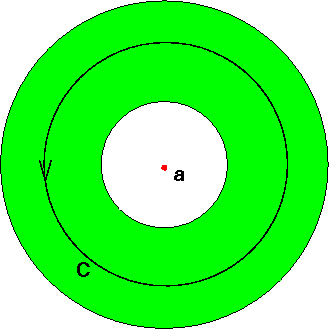Taylor and Laurent Series
- A sequence is a set of functions $u_1(z), u_2(z),\ldots$. We say it is convergent if a
sufficiently large $N$ can be found such that $u_n(z)$ is arbitrarily close to $U(z)$ for all $n>N$.
In that case $\lim_{n\to\infty}u_n(z)=U(z)$.
- The partial sum of $u_n(z)$ is defined as $s_n(z)=\sum_{m=1}^n u_m(z)$, and the full sum is an infinite series.
If this converges to $S(z)$, we can write $\lim_{n\to\infty}s_n(z)=S(z)$
- A necessary but not sufficient condition for convergence of $\{s_n(z)\}$ is that $\lim_{n\to\infty}u_n=0$.
- The geometric series $1+z+z^2+\ldots$ converges to $1/(1-z)$ for $|z|<1$.
- A series is absolutely convergent if $\sum_n |u_n(z)|$ is convergent. Clearly absolute convergence
implies convergence but the converse is not true.
- Uniform convergence within a region means that in the first definition above, a single $N$ is sufficient
for all $z$ in the region.
- The ratio test: a series is convergent if $\lim_{n\to\infty}|u_{n+1}/u_n| < 1$. If the limit is greater than
1 it is divergent and if equal to 1 we can't tell which from this test.
- A power series has the form $a_0+a_1(z-a)+a_2(z-a)^2+\ldots$. A power series is uniformly convergent
in a circular region about $a$, whose radius $R$ is called the radius of convergence. It may or may not converge
for $|z-a|=R$.
- If a function $f(z)$ is analytic within a circle radius $R$ centred on $a$, then according to Taylor's theorem
we can write $f(z)$ as a power series:
$$f(z)=f(a)+f'(a)(z-a)+f''(a)(z-a)^2/2!+\ldots+f^{(n)}(a)(z-a)^n/n!+\ldots$$
- The radius of convergence will be set by the position of the closest singularity to $a$.
- If in a Taylor series the coefficients of the first $n$ terms vanish, $f(z)$ has a zero of order $n$ at $z=a$.
 If a function $f(z)$ is analytic within an annulus of radii $R_1$ and $R_2$ centred on $a$, then
according to Laurent's theorem we can write $f(z)$ as follows:
$$f(z)=\sum_{n=1}\frac{b_n}{(z-a)^n} +\sum_{n=0}a_n(z-a)^n $$ where, taking the path of integration to lie in
the annulus,
$$a_n=\frac{1}{2\pi i}\oint \frac{f(z)}{(z-a)^{n+1}}\d z\qquad\text{and}\qquad
b_n=\frac{1}{2\pi i}\oint\; f(z)(z-a)^{n-1}\d z$$ The first series is called the principal part and the second the analytic part.
If a function $f(z)$ is analytic within an annulus of radii $R_1$ and $R_2$ centred on $a$, then
according to Laurent's theorem we can write $f(z)$ as follows:
$$f(z)=\sum_{n=1}\frac{b_n}{(z-a)^n} +\sum_{n=0}a_n(z-a)^n $$ where, taking the path of integration to lie in
the annulus,
$$a_n=\frac{1}{2\pi i}\oint \frac{f(z)}{(z-a)^{n+1}}\d z\qquad\text{and}\qquad
b_n=\frac{1}{2\pi i}\oint\; f(z)(z-a)^{n-1}\d z$$ The first series is called the principal part and the second the analytic part.
- If $b_m=0$ for all $m$, the series is just the Taylor series; this will be true only if $f(z)$ is in fact analytic inside the
inner radius of the annulus.
- If $z=a$ is a singularity of $f(z)$, we can form a Laurent series about $z=a$ which is valid for $0 < |z-a| < R$
where $R$ is the
distance to the next singularity. If the principal part terminates, so that $b_m=0$ for all $m > n$, we say f(z) has a pole of order $n$ at $z=a$. If $n=1$
we call it a simple pole. If there is no such value $n$, $z=a$ is an essential singularity.
- An entire function is analytic everywhere in the finite complex plane, and has a Taylor series about any point an with infinite
radius of convergence. A meromorphic function has a finite number of isolated singularities.
- Define $w=1/z$ and $g(w)=f(1/w)$. Then the nature of any singularity of $g$ at $w=0$ is the nature of any singularity
of $f$ at infinity.
Spiegel 6.1-5, (6.6), 6.7-12
Riley (18.4, 18.6), 18.13; Boas 14.4, 14.8; Arfken 6.5, 7.1
 If a function $f(z)$ is analytic within an annulus of radii $R_1$ and $R_2$ centred on $a$, then
according to Laurent's theorem we can write $f(z)$ as follows:
$$f(z)=\sum_{n=1}\frac{b_n}{(z-a)^n} +\sum_{n=0}a_n(z-a)^n $$ where, taking the path of integration to lie in
the annulus,
$$a_n=\frac{1}{2\pi i}\oint \frac{f(z)}{(z-a)^{n+1}}\d z\qquad\text{and}\qquad
b_n=\frac{1}{2\pi i}\oint\; f(z)(z-a)^{n-1}\d z$$ The first series is called the principal part and the second the analytic part.
If a function $f(z)$ is analytic within an annulus of radii $R_1$ and $R_2$ centred on $a$, then
according to Laurent's theorem we can write $f(z)$ as follows:
$$f(z)=\sum_{n=1}\frac{b_n}{(z-a)^n} +\sum_{n=0}a_n(z-a)^n $$ where, taking the path of integration to lie in
the annulus,
$$a_n=\frac{1}{2\pi i}\oint \frac{f(z)}{(z-a)^{n+1}}\d z\qquad\text{and}\qquad
b_n=\frac{1}{2\pi i}\oint\; f(z)(z-a)^{n-1}\d z$$ The first series is called the principal part and the second the analytic part.